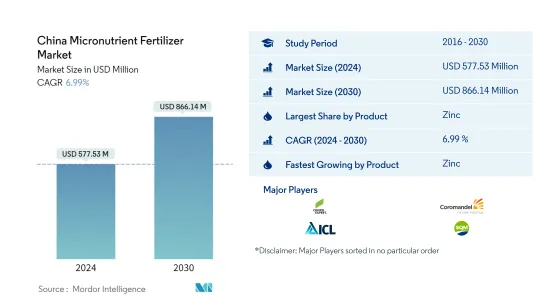Need help finding what you are looking for?
Contact Us
PUBLISHER: Mordor Intelligence | PRODUCT CODE: 1440519

PUBLISHER: Mordor Intelligence | PRODUCT CODE: 1440519
China Micronutrient Fertilizer - Market Share Analysis, Industry Trends & Statistics, Growth Forecasts (2024 - 2030)
PUBLISHED:
PAGES: 80 Pages
DELIVERY TIME: 2-3 business days
SELECT AN OPTION
The China Micronutrient Fertilizer Market size is estimated at USD 577.53 million in 2024, and is expected to reach USD 866.14 million by 2030, growing at a CAGR of 6.99% during the forecast period (2024-2030).

Key Highlights
- Largest Segment by Type - Zinc : Nearly 50% of arable agricultural soils in China are low in Zinc and limiting agricultural production. So, the rate of application of Zinc in the country is high.
- Fastest growing segment by Type - Zinc : Farmers of China are increasingly using zinc fertilizers due to increased zinc deficiencies and yield losses caused due to depleting soil quality.
- Largest Segment by Crop Type - Field Crops : Cultivation of field crops accounts for around 74% of the total agricultural land in the country and accounts for consumption of 74.4% of the total micronutrient fertilizes.
- Largest segment by Application Mode - Soil : It is a conventional way of fertilizer application and can be applied without any equipment. This method of application improves both plant health and soil fertility.
China Micronutrient Fertilizer Market Trends
Zinc is the largest segment by Product.
- Micronutrient deficiency in soils is a widespread problem across the country. Some of the micronutrients are abundant on the earth's crust due to their immobile nature. They cause micronutrient deficiencies in crops.
- Nearly half of China's arable soils are deficient in zinc, limiting agricultural production. Zinc is necessary for the formation of enzymes, proteins, and chlorophyll. As a result, zinc deficiency can reduce plant productivity and yield.
- Manganese is the most common micronutrient fertilizer used in crop production in the country. It accounted for about 28.8% of the total micronutrient fertilizer volume consumed in 2021. Manganese is essential for photosynthesis, the production of chlorophyll, the activation of enzymes, and the induction of cell division. Manganese levels of 20-40 ppm are adequate in most plant tissues. If it is less than 20 ppm, it is considered manganese deficient.
- Iron deficiency is a common nutritional problem in field crops in China, particularly in northern China, where aerobic and calcareous soils are common. In 2021, iron accounted for about 20.8% of the total micronutrient market volume in the country. Many enzymes involved in energy transfer, nitrogen reduction and fixation, and lignin formation contain iron.
- Most of the soils in China have an adequate amount of copper. However, in vegetable crops, the average copper nutrient application rate is 0.2% higher than the average copper application rate in field crops. Because copper is an immobile element in plants, symptoms of copper deficiency appear first in the plant's younger sections.
- Therefore, zinc, iron, and manganese micronutrient application in the country is relatively high compared to other micronutrients.
China Micronutrient Fertilizer Industry Overview
The China Micronutrient Fertilizer Market is moderately consolidated, with the top five companies occupying 52.62%. The major players in this market are Compo Expert GmbH, Coromandel International Ltd., ICL, Sociedad Quimica y Minera (SQM) and Yara China Limited (sorted alphabetically).
Additional Benefits:
- The market estimate (ME) sheet in Excel format
- 3 months of analyst support
Product Code: 92570
TABLE OF CONTENTS
1 EXECUTIVE SUMMARY & KEY FINDINGS
2 REPORT OFFERS
3 INTRODUCTION
- 3.1 Study Assumptions & Market Definition
- 3.2 Scope of the Study
- 3.3 Research Methodology
4 KEY INDUSTRY TRENDS
- 4.1 Acreage Of Major Crop Types
- 4.2 Average Nutrient Application Rates
- 4.3 Regulatory Framework
- 4.4 Value Chain & Distribution Channel Analysis
5 MARKET SEGMENTATION
- 5.1 Product
- 5.1.1 Boron
- 5.1.2 Copper
- 5.1.3 Iron
- 5.1.4 Manganese
- 5.1.5 Molybdenum
- 5.1.6 Zinc
- 5.1.7 Others
- 5.2 Application Mode
- 5.2.1 Fertigation
- 5.2.2 Foliar
- 5.2.3 Soil
- 5.3 Crop Type
- 5.3.1 Field Crops
- 5.3.2 Horticultural Crops
- 5.3.3 Turf & Ornamental
6 COMPETITIVE LANDSCAPE
- 6.1 Key Strategic Moves
- 6.2 Market Share Analysis
- 6.3 Company Landscape
- 6.4 Company Profiles
- 6.4.1 Compo Expert GmbH
- 6.4.2 Coromandel International Ltd.
- 6.4.3 Haifa Group
- 6.4.4 Hebei Monband Water Soluble Fertilizer Co. Ltd
- 6.4.5 ICL
- 6.4.6 Sociedad Quimica y Minera (SQM)
- 6.4.7 Yara China Limited
7 KEY STRATEGIC QUESTIONS FOR FERTILIZER CEOS
8 APPENDIX
- 8.1 Global Overview
- 8.1.1 Overview
- 8.1.2 Porter's Five Forces Framework
- 8.1.3 Global Value Chain Analysis
- 8.1.4 Market Dynamics (DROs)
- 8.2 Sources & References
- 8.3 List of Tables & Figures
- 8.4 Primary Insights
- 8.5 Data Pack
- 8.6 Glossary of Terms
Have a question?


SELECT AN OPTION
Have a question?


Questions? Please give us a call or visit the contact form.
